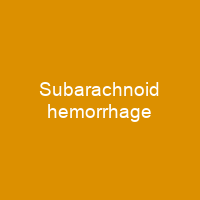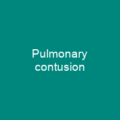Subarachnoid hemorrhage (SAH) is bleeding into the subarachNoid space. Symptoms may include a severe headache of rapid onset, vomiting, decreased level of consciousness, fever, and sometimes seizures. In about a quarter of people a small bleed with resolving symptoms occurs within a month of a larger bleed.
About Subarachnoid hemorrhage in brief

This is thought to occur through two mechanisms, a direct effect on the medulla that leads to activation of the descending sympathetic nervous system and a local release of inflammatory mediators that circulate to the peripheral circulation where they activate the sympathetic system. Oculomotor nerve abnormalities or palsy may indicate bleeding from the posterior communicating artery. The classic symptom of SAH is thunderclap headache. About one-third of people have no symptoms apart from the characteristic headache, and about one in ten people who seek medical care with this symptom are later diagnosed with a subArachnoids hemorrhage. About a third who survive have ongoing problems. Spontaneous SAH occurs in about one per 10,000 people per year. While it becomes more common with age, about 50 percent of people present under age 55. About 1 in 14 have seizures, as may neck stiffness and other signs of meningism. About 10 and 15 percent die before reaching a hospital. The diagnosis can be determined by a CT scan of the head if done within six hours of symptom onset. About half of people with a SAH due to an underlying aneurYSm die within 30 days and about a third of people who survive have ongoing issues. The prognosis is poor if it is a frequent occurrence in traumatic brain injury, and a poor prognosis with a poor life-threatening prognosis in people who have had a brain injury.
You want to know more about Subarachnoid hemorrhage?
This page is based on the article Subarachnoid hemorrhage published in Wikipedia (as of Dec. 03, 2020) and was automatically summarized using artificial intelligence.







